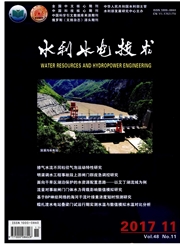

 中文摘要:
中文摘要:
海绵城市建设一定程度上增加了城市下垫面的种类,使得城市降雨径流的非线性关系更加复杂。以分析降雨特征对海绵小区的径流控制能力的影响为研究目标,以厦门市典型海绵小区为例,通过SWMM模型模拟计算,分析了降雨重现期、降雨历时和降雨峰现系数对海绵小区削峰减洪能力的影响,计算了不同设计降雨条件下普通开发小区、海绵小区的洪量削减率和洪峰削减率。结果表明:随着降水重现期由2年增加至100年,总洪量削减率由63.8%降至50.9%,洪峰削减率由66.0%降至37.4%;随着降雨历时从lh延长至6h,总洪量削减率由58.3%增至61.8%,洪峰削减率由63.7%降至56.3%;随着峰现系数从0.1增大到0.9,总洪量削减率由58.3%增至61.8%,洪峰削减率由63.7%降至56.3%;海绵小区削减洪峰的能力对降雨过程更为敏感,降雨量越大、峰值越靠后,越不利于洪峰流量的削减;而降雨量越大、历时越短,越不利于总径流量的削减。海绵小区整体在不同雨强下的效用比单一低影响开发措施更为稳定,证明了海绵城市建设中多种工程相结合、注重竖向设计的做法比大量建设某一种设施更为有效。研究成果为海绵城市规划和建设提供参考。
 英文摘要:
英文摘要:
The sponge city construction increases the types of the urban underlying surface to a certain scale and makes the urban non-linear rainfall-runoff relationship more complicated. The study on how the runoff control capacity of the sponge district is im- pacted by the rainfall characteristics is helpful for understanding and predicting the effects from the urban sponge bodies in differ- ent rainfall events, thus can provide references for planning and construction of sponge city. By taking a typical sponge district in Xiamen as the study case, the impacts from rainfall returning period, rainfall duration and rainfallpeak coefficient on the peak- clipping and flood reducing capacity of the sponge district are analyzed herein through the simulative calculation made by SWMM model ; from which both the flood volume reducing rate and the flood peak clipping rate of the sponge district under different de- sign rainfalls are calculated in comparison with the conventional district. The result shows that along with the increase of the rain- fall returning period from 2 years to 100 years, the total flood volume reducing rate is decreased from 63.84% to 50. 88% and the flood peak clipping rate is decreased from 65.98% to 37.42% ; along with the increase of rainfall duration from 1 h to 6 h, the total flood volume reducing rate is increased from 58.34% to 61.82% and the flood peak clipping rate is decreased from 63.73% to 56. 26% ; along with the increase of the flood peak coefficient from 0. 1 to 0. 9, tile total flood volume reducing rate is increased from 58.34% to 61.82% and the flood peak clipping rate is decreased from 63.73% to 56.26%. The flood peak clipping capacity is mo~ sensitive to the rainfall process, i.e. the larger the rainfall volume is, the more lagged the peak value is to be and the more unfavorable is to be for the reduction of the flood peak flow rate ; while the larger the rainfall volume is, the shorter the duration is to be and the more unfavorable is to be for the reduction of the total runoff. Under
 同期刊论文项目
同期刊论文项目
 同项目期刊论文
同项目期刊论文
 期刊信息
期刊信息
